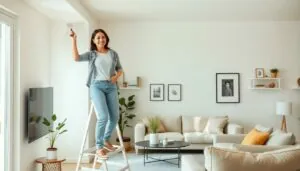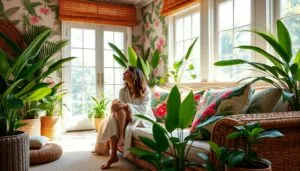Interior design sketches are like the secret sauce of any great home makeover. They capture the essence of a space before the paint dries and the furniture gets moved in. Think of them as the blueprints of creativity where imagination runs wild and anything is possible—like that time your friend tried to convince you that a neon green sofa was a good idea.
These sketches aren’t just pretty doodles; they’re powerful tools that help designers bring their visions to life. Whether it’s a cozy nook or a sprawling living room, a well-crafted sketch can save time, money, and a lot of awkward “what were they thinking?” moments. Dive into the world of interior design sketches and discover how they can transform your space from drab to fab, one pencil stroke at a time.
Table of Contents
ToggleOverview of Interior Design Sketches
Interior design sketches play a crucial role in the design process. These visual representations capture critical elements of a space, including layout, color schemes, and furniture placement. Creatively, they serve as preliminary drafts, allowing designers to explore various concepts without committing to physical changes.
Professionals use different types of sketches, such as rough drafts and detailed renderings, to communicate ideas effectively. Rough drafts focus on layout and functionality, while detailed renderings provide insight into textures and colors. Both types contribute to a comprehensive understanding of the final design.
Moreover, sketches aid in identifying potential challenges early on. They allow designers to visualize space limitations, enabling proactive problem-solving. By analyzing sketches, designers determine optimal placement for light fixtures and furniture, ensuring a harmonious balance.
Clients benefit from seeing sketches, as they foster collaboration and feedback. Engaging in discussions around these visuals helps align the designer’s vision with the client’s preferences. Constructive dialogue leads to refinements that enhance overall satisfaction with the final outcome.
Furthermore, sketches serve as valuable documentation throughout the interior design process. They provide a reference point for designers, assisting in preserving creative ideas over time. This documentation helps maintain consistency during implementation, ensuring every detail aligns with the original vision.
Ultimately, these sketches stand as foundational tools in the realm of interior design. They empower designers to express their creativity, improve communication with clients, and streamline the entire design process.
Importance of Interior Design Sketches

Interior design sketches play a vital role in shaping spaces. These sketches facilitate effective communication between designers and clients.
Visual Communication Tool
Designers rely on sketches to convey ideas and concepts visually. Sketches provide a clear representation of layout and aesthetics. They help clients understand proposed designs, making abstract ideas tangible. With sketches, the potential for miscommunication diminishes, allowing for focused discussions. Each sketch acts as a common language, bridging gaps in understanding.
Concept Development
Sketches aid in developing design concepts by outlining initial ideas. They allow designers to experiment with layouts and color choices quickly. Early sketches highlight key elements of the design, ensuring all critical components are considered. Designers can refine aesthetics and functionalities through iterative sketches. Each stage of sketching reveals insights into how a space may evolve, guiding final decisions effectively.
Types of Interior Design Sketches
Interior design sketches come in various forms, each serving distinct purposes in the design process. Hand-drawn sketches and digital sketches are two primary types, both integral for visualizing and communicating design concepts.
Hand-Drawn Sketches
Hand-drawn sketches offer a personal touch and spontaneity that digital methods can’t replicate. Designers often use pencils or markers to capture initial ideas quickly, making adjustments easily on paper. Surprisingly, this analog approach fosters creativity, allowing for free expression and exploration of different concepts. They emphasize layout and spatial relationships, highlighting furniture arrangement and flow in a space. Clients appreciate these sketches for their artistic quality, which often sparks engaging discussions during the design process. Visualizing ideas through hand-drawn sketches encourages collaboration and helps align the designer’s vision with the client’s preferences.
Digital Sketches
Digital sketches have quickly gained popularity due to their efficiency and precision. Designers utilize software tools to create clean, detailed representations of design ideas. These sketches allow for easy modifications and immediate access to various textures and color palettes. Digital formats enable design teams to share their work instantly, promoting collaboration across geographical boundaries. Furthermore, clients can visualize designs through enhanced features like 3D rendering. The versatility of digital sketches makes them invaluable in presenting complex ideas clearly. Designers favor this method for its ability to streamline workflows while maintaining consistency and accuracy throughout the design process.
Techniques for Creating Effective Sketches
Creating effective sketches involves mastering several key techniques that enhance clarity and communication. Two vital aspects are perspective drawing and color theory.
Perspective Drawing
Perspective drawing captures depth and space effectively in interior design sketches. Utilizing one-point and two-point perspectives allows designers to create accurate representations of rooms. Artists position vanishing points strategically to simulate how objects appear smaller as they recede. By establishing a horizon line, the sketch maintains proportionality, aiding in the viewer’s understanding. Accurate perspective enhances visual representation, allowing clients to visualize spatial relationships. Designers often incorporate furniture and fixtures into the perspective, making layouts clearer. Realism generated through perspective drawing helps clients connect with the design on a deeper level.
Color Theory and Application
Color theory plays a crucial role in interior design sketches, impacting mood and spatial perception. Understanding color harmony, designers select palettes that evoke desired feelings. Complementary colors create dynamic contrasts, while analogous colors ensure cohesion. Application involves strategic placement to guide the viewer’s eye and highlight key features. Color swatches incorporated in sketches assist clients in visualizing the overall ambiance. Designers consider lighting effects, as natural and artificial light alters colors throughout the day. This informed approach allows designers to propose palettes that enhance the space’s aesthetic appeal. Balancing color choices leads to effective communication of design intentions.
Tools and Resources for Interior Design Sketching
Interior design sketching requires a mix of traditional and digital tools. Each category offers essential resources that enhance the sketching process.
Traditional Tools
Graphite pencils serve as a staple for initial ideas. Designers often utilize fine-tipped pens for detailed outlines and sketches. Sketchbooks allow for portability, making it easy to capture inspiration anytime. Additionally, rulers and compasses aid in achieving precise lines and accurate proportions. Designers also employ markers and colored pencils to present color schemes and textures. Watercolors can add artistic flair to sketches, creating a more dynamic presentation. Tracing paper provides versatility for refining designs or creating overlays of different concepts.
Digital Tools
Software programs like AutoCAD help designers create precise floor plans and detailed renderings. SketchUp offers intuitive 3D modeling capabilities, allowing for realistic visualizations. Adobe Photoshop and Illustrator are popular for enhancing and finalizing sketches with professional touches. Tablets equipped with styluses provide a seamless way to sketch digitally, combining the feel of hand drawing with the efficiency of technology. Cloud storage services facilitate easy collaboration and sharing, ensuring all stakeholders have access to the latest versions. Furthermore, sketching apps on various devices streamline the creative process, making it convenient to revise ideas on the go.
Interior design sketches are invaluable assets in the creative process. They bridge the gap between concept and reality, allowing designers to visualize and refine their ideas before implementation. By fostering collaboration and enhancing communication with clients, sketches ensure that everyone is aligned on the vision for the space.
The variety of sketching techniques and tools available empowers designers to express their creativity while addressing practical concerns. Whether opting for hand-drawn artistry or digital precision, these sketches play a crucial role in transforming spaces into stylish and functional environments. Ultimately, they serve as the foundation for successful interior design projects, guiding decisions and inspiring innovative solutions.




